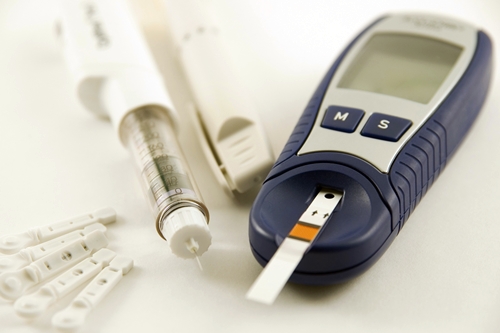26 January 2016. Engineering and biochemical researchers developed a material that in lab animals holds and protects transplanted pancreatic beta cells against an immune reaction, a key advance in treatments for individuals with type 1 diabetes. Teams from Massachusetts Institute of Technology and other institutions published their findings about the material in the 25 January 2016 issues of Nature Biotechnology and Nature Medicine (paid subscriptions required).
Type 1 diabetes, sometimes called insulin-dependent, immune-mediated, or juvenile-onset diabetes, is caused by an auto-immune reaction where the body’s defenses attack its own insulin-producing beta cells in the pancreas. Without enough insulin, glucose builds up in the blood stream instead of going into the cells, leading to type 1 diabetes symptoms. Some 1.25 million people in the U.S. have type 1 diabetes, including many children and young adults, who need to replace their insulin supply daily through injections or devices such as insulin pumps.
A promising alternative to these solutions is transplanted healthy beta cells that produce insulin derived from embryonic stem cells, in people with type 1 diabetes. These cell transplants, however, induce an immune reaction, which requires recipients to take drugs that suppress the immune system.
Research teams led by MIT engineering and biochemistry professor Daniel Anderson developed a material to cloak transplanted beta cells from the immune system. The material is an alginate hydrogel derived from natural algae that previously was shown to hold and protect transplanted cells, yet still allow proteins and nutrients to pass through. Alginate gels, however, still provoke immune reactions leading to scar tissue that builds up around the transplant sites.
In the Nature Biotechnology paper, Anderson and colleagues described the process for engineering alginate gels to find a version that meets the needs of beta cell transplants. The team used computerized lab screening to test the properties of some 800 alginate derivatives, and identified three compounds with triazole, a hydrogen-carbon-nitrogen chemical tested in some biomedical applications. The researchers found the triazole-boosted alginate inhibited immune reactions, including scar tissue, in lab rodents and monkeys for at least six months.
Another team then tested transplanted beta cells derived from embryonic stem cells in lab mice with healthy immune systems, but chemically induced with type 1 diabetes, as reported in the Nature Medicine article. For these transplants, the researchers packaged the cells in an alginate gel with triazole-thiomorpholine dioxide that performed better than the other triazole-alginate compounds.
The results show the transplanted beta cells performed normally, producing needed quantities of insulin, and continued to function for nearly six months. No immune reactions were reported, nor were immune-system suppressant drugs needed.
Collaborators on the project include researchers from Harvard University, the University of Illinois at Chicago, the Joslin Diabetes Center, and the University of Massachusetts Medical School. Among the collaborators is Douglas Melton, co-director of Harvard’s Stem Cell Institute, who in October 2014, and reported in Science & Enterprise, revealed a technique for producing large quantities of beta cells from embryonic stem cells.
Anderson and several MIT co-authors are listed as inventors on patents filed for the hydrogel material. Melton and Harvard co-authors are inventors on a patent filed by Harvard University for the technology producing beta cells from embryonic stem cells.
Read more:
- Diabetes Biotech Acquires GSK Spin-Off
- Sanofi, Google to Partner on Diabetes Care, Devices
- Glucose Control Implant Bests Diabetes Drug in Trial
- Mobile Diabetes Device Maker Lands $20M in Venture Funds
- MedImmune, Joslin Partner on Diabetes Research
* * *


 RSS - Posts
RSS - Posts
You must be logged in to post a comment.